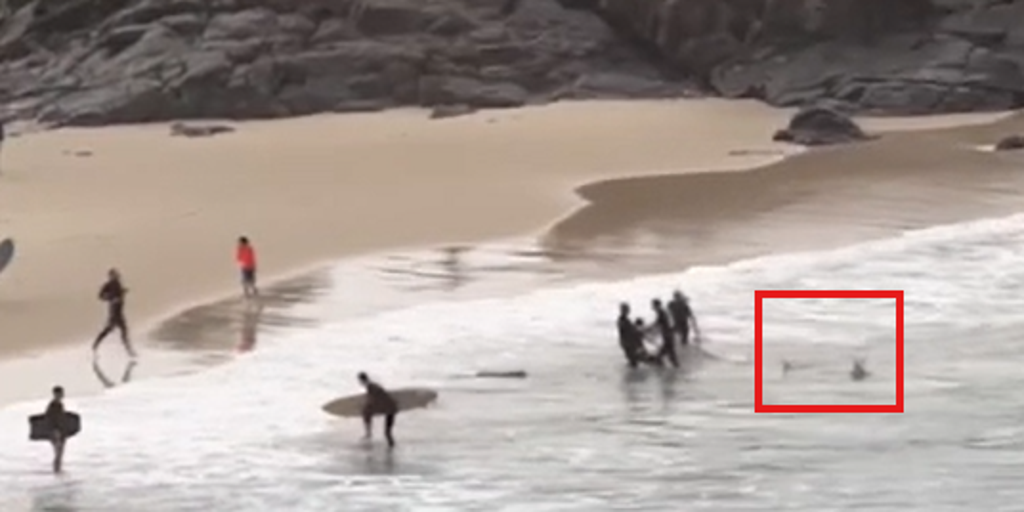Shark Encounter at Cabarita Beach: A Deep Dive into Ocean Risks
On a sunny Sunday afternoon, the idyllic shores of Cabarita Beach in New South Wales transformed into a scene of chaos and fear. Witnesses watched as a shark attacked a 16-year-old surfer, first leaving him injured in the water, then pursuing a band of surfers who dared to rescue him. This harrowing incident, captured on video, has ignited discussions around the rising frequency of shark encounters along Australia’s beaches—a phenomenon that underscores the intricate relationship between human activity and oceanic life.
The Incident: A Closer Look
As the video footage circulated, viewers were transfixed. It opened a window into an unexpected world where the line between danger and adventure is often blurred. The anxious cries of onlookers underscored the panic; one woman captured the sentiment, exclaiming, “That’s so scary; I was literally there.” As surfers painstakingly pulled the injured boy from the shallow surf, the shark hovered ominously behind them. This surreal dance between predator and potential rescuers is emblematic of the complex dynamics playing out in our oceans.
Nature’s Instincts in Focus
According to Dr. Alice Thompson, a marine biologist at the University of Sydney, understanding shark behavior is crucial in addressing these incidents. “Sharks often mistake surfers for other marine animals, but what we see is a defense mechanism; they’re not typically aggressive unless provoked,” she notes. Recent studies published in the *Journal of Marine Biology* indicate that shark attacks have fluctuated based on environmental factors such as temperature shifts and migratory patterns.
- Increased water temperatures have led to a broader range of species exploring shallower waters.
- Urbanized coastal areas have seen a rise in human-shark interactions, altering marine ecosystems.
- Shark migration patterns are shifting due to climate change and fishing practices.
The Aftermath: Community Response
As rescuers brought the injured surfer to safety, the beach quickly filled with concerned locals. Reports indicate that he suffered severe injuries to his right side, affecting his hand, arm, and leg. While the precise details of his condition remain unclear, eyewitnesses described a frantic but organized rescue effort marked by swift calls for professional medical assistance.
“The community response was remarkable, reflecting a deep-rooted sense of camaraderie among surfers,” said Jake Roberts, a veteran lifeguard at Cabarita Beach. “Yet, we have to confront the evolving challenges of marine life as human activities continue to encroach upon their habitats.”
A Temporary Calm Amid Ongoing Tensions
Despite the immediate dangers, many surfers returned to the water shortly after the event. Such resilience speaks to a culture that has long romanticized ocean life, a stark contrast to the very real risk posed by predators lurking beneath the surface. While locals are aware of the risks, the allure of surfing—freedom, thrill, community—often overshadows concerns about safety.
Shark Encounters: A Global Perspective
Experts argue that this incident at Cabarita Beach is not an isolated occurrence. Data from the Australian Shark Incident Database indicates a gradual uptick in attacks over the past two decades. More alarmingly, research has found that 50% of all serious shark incidents occur in areas heavily trafficked by humans.
Dr. Marcus Hill, an oceanographer specializing in shark migration, emphasizes the multifaceted nature of this issue. “We must consider varying factors—climate change, overfishing, and even bait practices affecting shark behavior,” he asserts. In fact, studies highlight that areas with high fishing activity experience increased shark encounters, as populations are drawn to discarded fish and bait.
The Role of Conservation
As debates swirl around public safety and environmental conservation, the question arises: How can we strike a balance? Marine scientists advocate for a more cohesive approach involving:
- Enhanced public education about shark behavior and safety measures.
- Implementing shark nets or drumlines only in areas with high risk during peak seasons.
- Collaborating with local communities to promote coexistence with marine life.
Such initiatives not only aim to prevent encounters but also emphasize the need for ongoing scientific research. Understanding the underlying factors driving shark behavior can offer invaluable insights into risk mitigation.
A Natural Balance: Living with Ocean Life
The psychological impact of the shark attack at Cabarita Beach extends far beyond the ocean. As communities grapple with the realities of an ocean filled with enthralling yet hazardous creatures, the need for a balanced narrative is critical. “We cannot paint sharks solely as monsters; they are a vital part of our ecosystem,” Dr. Thompson reminds us. The balance we seek between safety and conservation ultimately shines a light on our responsibility to coexist with ocean life respectfully and knowledgeably.
The young surfer’s bravery, coupled with the swift collective response of witnesses, paints a hopeful picture amid a tragic event. Though the ocean may harbor threats, it also offers life, adventure, and connection to humanity. As lessons unfold from incidents like this, our approach to the ocean may evolve, striving for a harmonious relationship with the great blue depths.









